“The wars of the 21st Century will be fought over water.” —Ismail Serageldin, World Bank

Watching the devastation and havoc caused by Hurricane Sandy and several recent water-related natural disasters, it’s hard to imagine that global water shortages represent an environmental crisis on par with climate change. But if current water usage habits do not abate, or if major technological advances to help recycle clean water are not implemented, this is precisely the scenario we are facing—a majority of 21st Century conflicts being fought over water. From the producers of socially-conscious films An Inconvenient Truth and Food, Inc., Last Call at the Oasis is a timely documentary that chronicles current challenges in worldwide water supply, outlines the variables that contribute to chronic shortages and interviews leading environmental scientists and activists about the ramifications of chemical contamination in drinking water. More than just an environmental polemic, Last Call is a stirring call to action for engineering and technology solutions to a decidedly solvable problem. A ScriptPhD.com review under the “continue reading” cut.
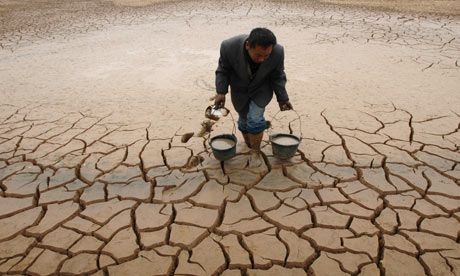
Although the Earth is composed of 70% water, only 0.7% (or 1% of the total supply) of it is fresh and potable, which presents a considerable resource challenge for a growing population expected to hit 9 billion people in 2050. In a profile series of some of the world’s most populous metropolises, Last Call vividly demonstrates that stark imagery of shortage crises is no longer confined to third world countries or women traveling miles with a precious gallon of water perched on their heads. The Aral Sea, a critical climate buffer for Russia and surrounding Central Asia neighbors, is one-half its original size and devoid of fish. The worst global droughts in a millennium have increased food prices 10% and raised a very real prospect of food riots. Urban water shortages, such as an epic 2008 shortage that forced Barcelona to import emergency water, will be far more common. The United States, by far the biggest consumer of water in the world, could also face the biggest impact. Lake Mead, the biggest supplier of water in America and a portal to the electricity-generating Hoover Dam, is only 40% full. Hoover Dam, which stops generating electricity when water levels are at 1050 feet, faces that daunting prospect in less than 4 years!
One strength of Last Call is that it is framed around a fairly uniform and well-substantiated hypothesis: water shortage is directly related to profligate, unsustainable water usage. Some usage, such as the 80% that is devoted to agriculture and food production, will merit evaluation for future conservation methods. California and Australia, two agricultural behemoths half a world apart, both face similar threats to their industries. But others, such as watering lawns. are unnecessary habits that can be reduced or eliminated. Toilets, most of which still flush 6 gallons in a single use, are the single biggest user of water in our homes—6 billion gallons per day! The US is also the largest consumer of bottled water in the world, with $11 billion in sales, even though bottled water, unlike municipal tap water, is under the jurisdiction of the FDA, not the EPA. As chronicled in the documentary Tapped, 45% of all bottled water starts off as tapped water, and has been subject to over 100 recalls for contamination.
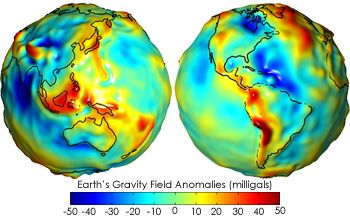
A cohort of science and environmental experts bolsters Last Call’s message with the latest scientific research in the area. NASA scientists at the Jet Propulsion Laboratory are using a program called the Gravity Recovery and Climate Experiment (GRACE) Satellite to measure the change in oceans, including water depletion, rise in sea levels and circulation through a series of gravity maps. Erin Brockovich, famously portrayed by Julia Roberts in the eponymous film, appears throughout the documentary to discuss still-ongoing issues with water contamination, corporate pollution and lack of EPA regulation. UC Berkeley marine biologist Tyrone Hayes expounds on what we can learn from genetic irregularities in amphibians found in contaminated habitats.
Take a look at a trailer for Last Call at the Oasis:
Indeed, chemical contamination is the only issue that supersedes overuse as a threat to our water supply. Drugs, antibiotics and other chemicals, which cannot be treated at sewage treatment plants, are increasingly finding their way into the water supply, many of them at the hands of large corporations. Between 2004 and 2009, there were one half a million violations of the Clean Water Act. Last Call doesn’t spare the eye-opening details that will make you think twice when you take a sip of water. Atrazine, for example, is the best-selling pesticide in the world, and the most-used on the US corn supply. Unfortunately, it has also been associated with breast cancer and altered testosterone levels in sea life, and is being investigated for safety by the EPA, with a decision expected in 2013. More disturbing is the contamination from concentrated animal feeding operations (CAFOs) near major rivers and lakes. Tons of manure from cows, one of which contributes the waste of 23 humans, is dumped into artificial lagoons that then seep into interconnected groundwater supplies.

It’s not all doom and gloom with this documentary, however. Unlike other polemics in its genre, Last Call doesn’t simply outline the crisis, it also offers implementable solutions and a challenge for an entire generation of engineers and scientists. At the top of the list is a greater scrutiny of polluters and the pollutants they release into the water supply without impunity. But solutions such as recycling sewage water, which has made Singapore a global model for water technology and reuse, are at our fingertips, if developed and marketed properly. The city of Los Angeles has already announced plans to recycle 4.9 billion gallons of waste water by 2019. Last Call is an effective final call to save a fast-dwindling resource through science, innovation and conservation.
Last Call at the Oasis went out on DVD November 6th.
~*ScriptPhD*~
*****************
ScriptPhD.com covers science and technology in entertainment, media and advertising. Hire our consulting company for creative content development.
Subscribe to free email notifications of new posts on our home page.
]]>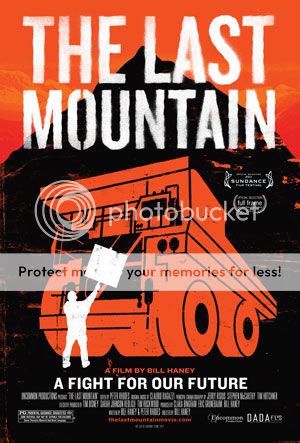
About a year ago, a little publicized, unheralded documentary named Mountaintop Removal (which ScriptPhD.com reviewed) attempted to deconstruct the environmentally devastating practice of the same name literally destroying the Appalachian geography of West Virginia’s coal river valley. Honest, yet modestly shot and produced, the small-scale documentary needed a Hollywood touch to resonate on a human level to advance its powerful cause. It got what it needed in The Last Mountain, a celebrated selection of this year’s Sundance Film Festival. This important new documentary succeeds in both relaying the urgency of a destructive coal mining practice that is literally zoning in on one last undamaged mountain as well as forging a human connection with the townspeople battling to save it. Full ScriptPhD.com review under the “continue reading” cut.
Most people don’t think twice about where the electricity for their light bulbs comes from. Or if they know it primarily comes from coal, they are not aware of how that coal comes to see the light of day. In the valleys and mountaintops of idyllic Appalachia, the coal industry detonates the explosive power of a Hiroshima bomb every week, utilizing a crude process called mountaintop removal. There is nothing scientific or technical about mountaintop removal. It is crude, cruel and its effects non-reversible. First, trees and other natural ecology are removed from the tops of mountains. Then, dynamite splits the mountain open to unearth a layer of coal that is mined by brave men risking their lives in ungodly working conditions. When the layer is depleted, the next layer is blasted, until nothing is left but a hollow shell of a devastated mountain. In its wake, the process leaves behind toxic sludge piles containing arsenic, lead and mercury, contaminated rivers and streams, fine particulate airborne matter that creates an epidemiological health nightmare, and unlivable communities. Mountaintop removal has already destroyed 500 Appalachian mountains, decimated 1 million acres of forests, and buried 2,000 miles of streams.
Take a look at a clip from The Last Mountain that shows the destruction from an aerial view:
In the beautiful mountains of the Coal River Valley in West Virginia, mining corporations such as Massey Energy are blasting the mountains of Appalachia into extinction, polluting the air and water with blithe impunity, and amassing the kind of profits that allow them to wield massive lobbying power in Washington, DC to both repeal existing environmental regulations and obviate the ratification of new ones. One small community has had enough. Their only schoolhouse sits at the base of a silo where 28 million gallons of toxic sludge left over from the coal mining are held back by a flimsy levee. Their neighbors and friends—ranging from 5 to 63 years old to—are dying in masses from strange tumor clusters. Water filters that should last 3-4 months get plugged up after two weeks. The very last mountain in Coal River, protecting the community from massive flooding after rainfall, is being targeted for blasting. And that is when the people of Coal River decide to fight back.
The Last Mountain is not just a standard environmental cautionary tale, but also an uplifting tale of citizens taking back their community. Helping the cause is noted environmentalist Robert F. Kennedy, Jr., who travels to Coal River, aligns with the community, and attends dozens of rallies that are held to protest the actions of Massey Energy. In one of the film’s lighter moments, a humble West Virginian remarks “I never thought I’d have a Kennedy in my living room!” It is these very human moments that ultimately connect the audience to a cause seemingly unrelated to our lives. The most poignant moment of The Last Mountain is live footage of Coal River residents that had traveled to the governor’s offices in Charlotte to present him with money raised through a local Pennies For Promise campaign to build a new, safer schoolhouse (an ultimately successful initiative.) At first the governor is touched, even amused, by the rural denizens. But when they bring up the actions of Massey Energy, and the governor’s own futility in stopping the damage to their community, he is stunned, even embarrassed, even going so far as to have the West Virginia government arrest the protesters—one of whom was a 91-year-old woman in a flag-draped wheelchair. “Why are our kids any different?” former Massey Energy contractor turned activist Ed Wiley shouts at the governor. “Because they’re in the coal fields? They’re on the wrong side of the mountain?”
If you think this movie, or mountaintop removal itself, doesn’t affect you, you’re wrong. Almost half of the electricity produced in the US comes from the burning of coal (that’s 16 pounds of coal each day for each man, woman, and child!). 32% of that coal comes from…you guessed it…the mountains of Appalachia. It also happens to be the #1 sources of greenhouse gases worldwide. And it doesn’t stop there. The toll on health from the burning of coal nationwide—contributing to such problems as 10 million asthma attacks, brain damage in newborns and thousands of premature deaths—adds up to $345 billion annually. We are all paying the cost of mountaintop removal in one way or another. You’re connected to coal, whether you realize it or not.
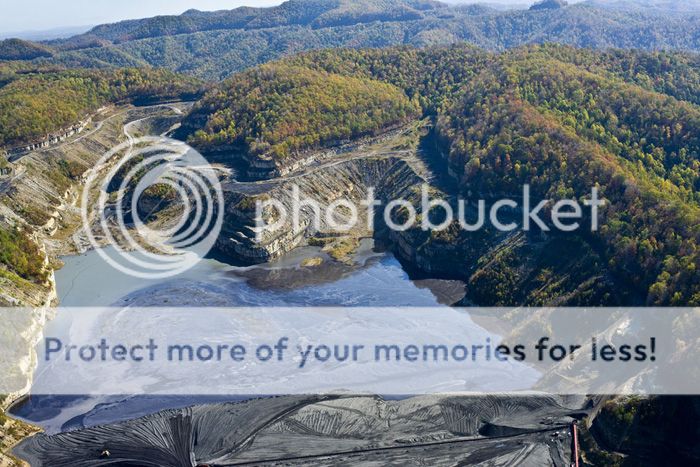
As The Last Mountain eventually conveys, this is a tale about so much more than blasting off a mountain—it’s about hubris and powerful people thinking they can do whatever they want, while destroying lives in the process. How’s this for a silent statistic? Massey Energy’s 28 impoundments have spilled 24 times in the last decade, contaminating rivers with 300 million gallons of sludge—that is twice the amount released in the BP oil spill in the Gulf that shocked the world. After a $28 million dollar settlement for their environmental violations, Massey Energy committed 180 more violations with no impunity. And the tragic thing is that the alternative technology is so much more effective and inexpensive. The filmmakers end with an uplifting visit to Portsmouth, WV, a municipality that supplies ¾ of its electricity needs for the community with two windmills with low-grade Category 2 winds. The winds in the Coal River Valley? The highest possible—Category 5. One can only imagine how many jobs and clean energy could be created from wind turbines in the Coal River Valley. A 1991 Department of Energy study concluded that only three US States, Kansas, North Dakota and Texas, have enough harnessable wind energy to supply the entire nations energy needs. Twenty years later, we have the technology to make it happen.
The ultimate message of The Last Mountain is that is not enough to simply be outraged anymore. We are all users of the electricity and power that is generated from the sacrifices of the Appalachia residents and miners. The imagery of environmental devastation is so shocking, the deregulation and egregious indifference of the coal mining companies’ various violations so appalling, that we begin to feel somehow complicit in perpetrating this modern American tragedy. Fixing it starts with watching documentaries like The Last Mountain, but also in taking the kind of inspiring action as that of the small rural West Virginia community that the film portrays. Ordinary people, banded together in a common purpose, can indeed move mountains. And sometimes, they can even save them.
Trailer:
The Last Mountain was released in limited screenings on June 15th, and goes into theaters nationwide later in June.
~*ScriptPhD*~
*****************
ScriptPhD.com covers science and technology in entertainment, media and advertising. Hire our consulting company for creative content development.
Subscribe to free email notifications of new posts on our home page.
]]>
In April of 2010, the California Science Center added a 45,000 square foot permanent exhibit called ‘Ecosystems,’ nearly doubling the size of the museum. Ten years in the making, at a cost of $165 million, ‘Ecosystems’ manages to impress visually and scholastically. ScriptPhD.com recently got a private tour and in-depth guide of the ambitious exhibit and didactic tool. Afterwards, we had the opportunity to sit down with the man that conceptualized ‘Ecosystems’ and curator of ecology at the California Science Center — Dr. Chuck Kopczak. An avid geologist, and devoted to the promulgation of quality science education, Dr. Chuck graciously sat down with us for an in-depth conversation about ‘Ecosystems,’ the future of science education, and energizing environmental causes through science. Our full tour and podcast, under the “continue reading” cut.
How can we protect and nurture our Earth’s diverse environment if we don’t even know about it? The Earth’s biodiversity is spectacular, with a singular globe housing millions of unique species that have to share space across extreme environments, weather zones and poles. Scientists concur that a better understanding of this diversity, and humanity’s impact on it through our modern life (we add 7 million people to the globe each month!), is an essential component of environmental education and effective activism in fighting pollution and effecting sustainability for future generations. In the heart of Los Angeles, at its most-visited museum, The California Science Center, lies a new exhibit that takes curious visitors through the various ‘zones’ of the Earth’s habitats, with each room providing a colorful, interactive, informative peek at what survival entails. At the very end of the ‘Ecosystems’ exhibit, after we have come to appreciate our Earth’s uniqueness, beauty, and scientific breadth, is a well-timed section on waste, resources, and the power of recycling. Come take a short pictorial tour of ‘Ecosystems’ with us, and then take a listen to our podcast with the passionate scientist, Dr. Chuck Kopczak, that made it all possible.
‘Ecosystems’ is divided into rooms called ‘Zones,’ some of which we’ve documenting here, consisting of a gallery that engenders appreciation for the interconnectedness of a different part of our living world. Portrayed are different environments, species, survival demands, and physical factors. All of the rooms include interactive, hands-on experiments especially tailored for kids.
The ‘Island Zone’ includes hands-on experiments that allow visitors to see the challenge animals face in getting to an island from water, and how their physical characteristics evolve as a result of these environmental demands. The exhibit mimics the discoveries that Darwin might have encountered on the Galapagos Islands.

The ‘Extreme Zone’ includes radically different environments representing ecosystems — Rocky Shore, Poles, Deep Sea Vents, and the Desert, both pictured below. Environmental factors such as cold, droughts, and ice deeply test the limits of animals as they try to survive.
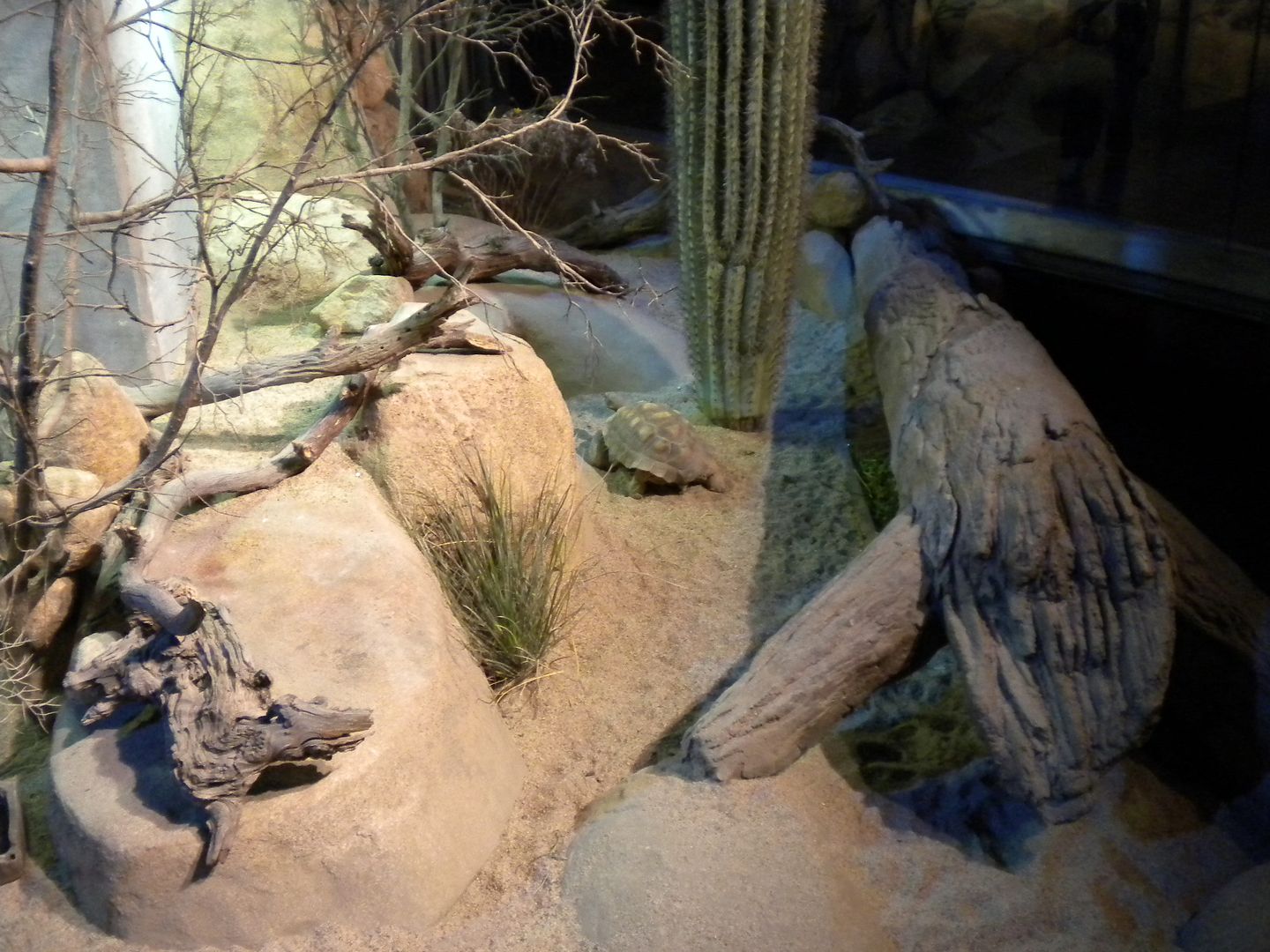

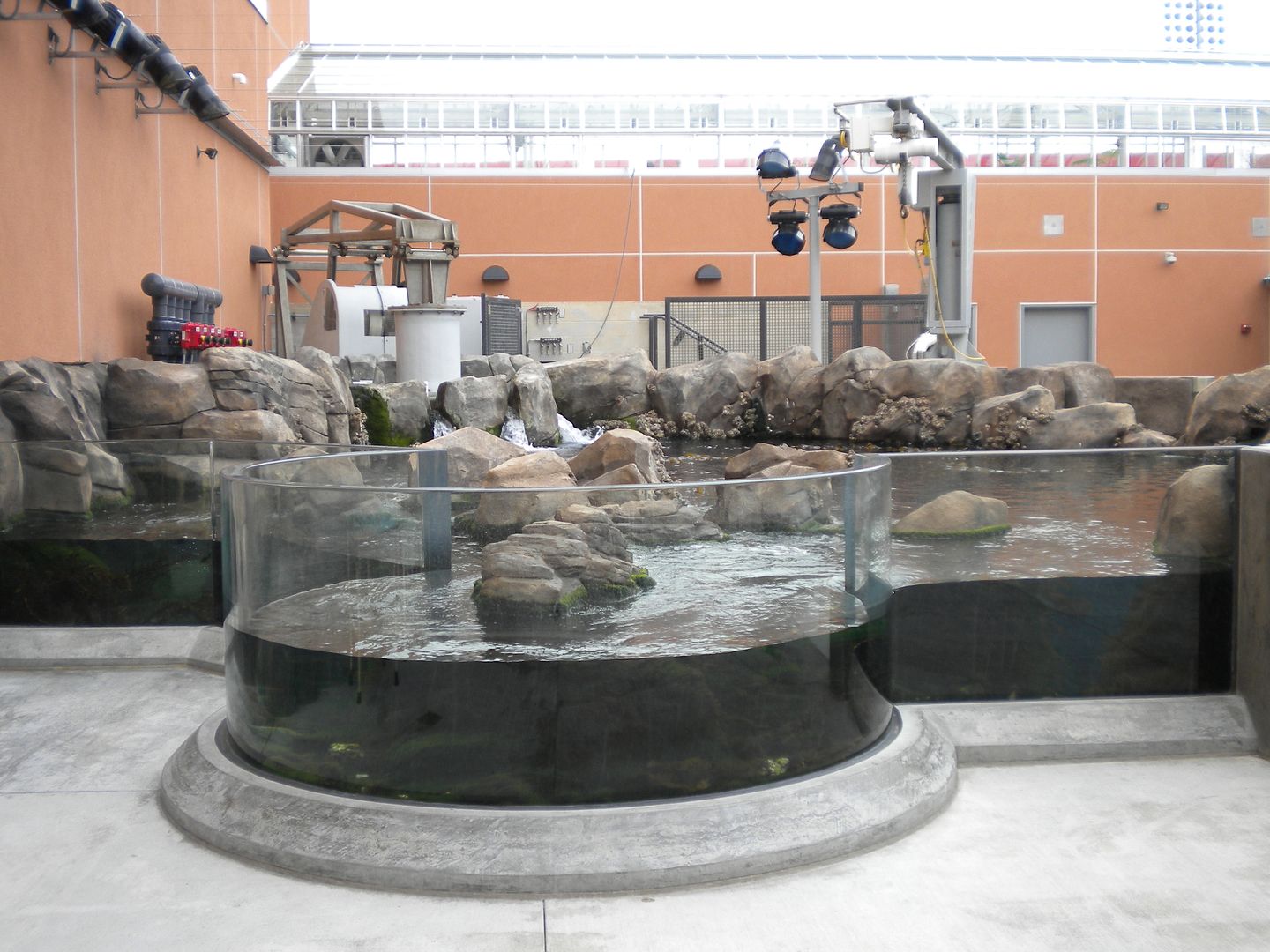
The Global Zone allows visitors to travel around the world with an amazing, first-of-its-kind piece of technology: an internal projection high definition Magic Planet® exhibit, projecting images onto a global map from within the sphere to answer questions about matter and energy across the globe.
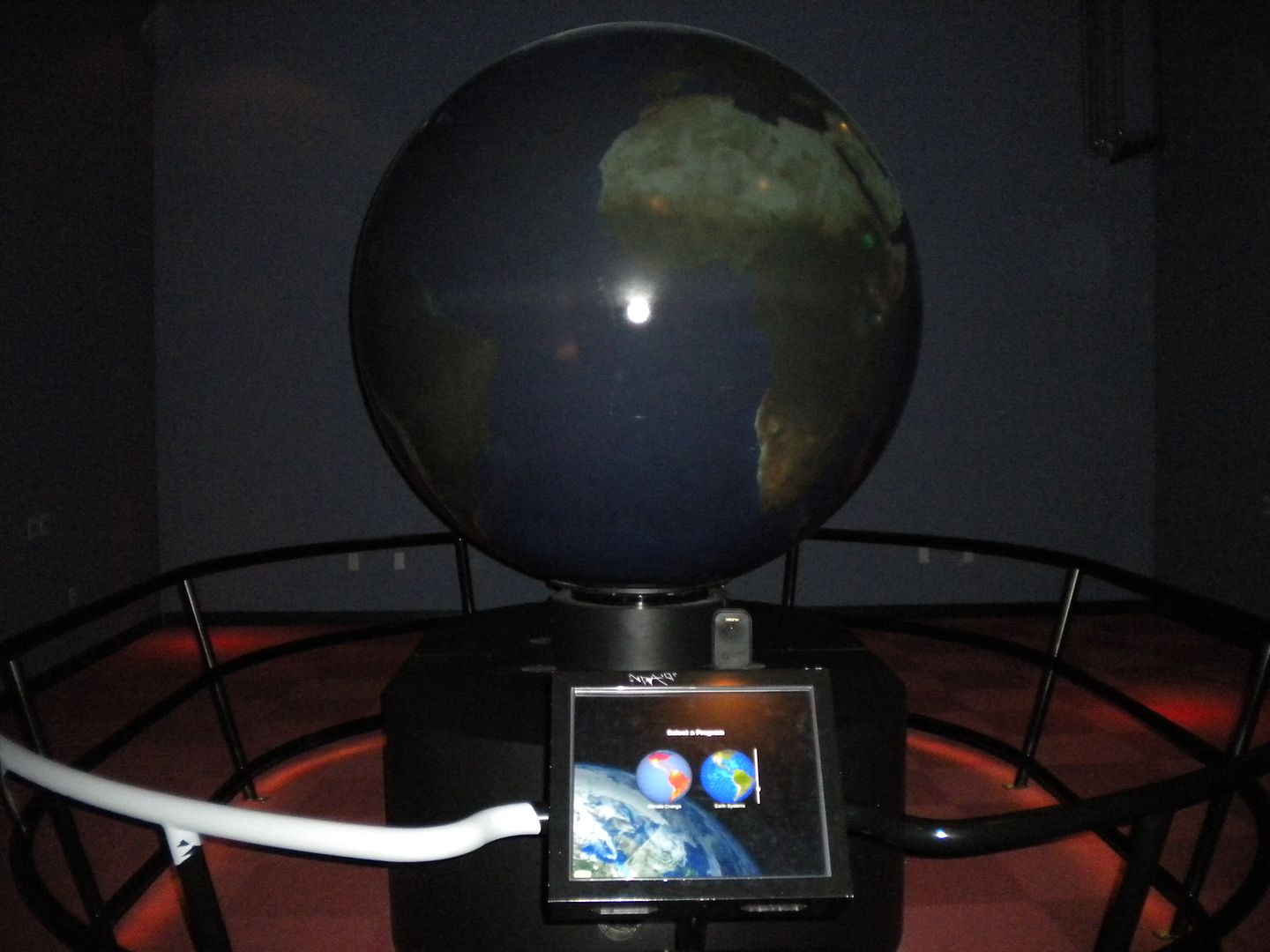
One of the fan favorites of ‘Ecosystems’ is the ever-so-gross Rot Room, where folks can learn about how much the continuity of life depends upon, well… rot. Interactive decomposition exhibits (such as the one pictured below) and time-lapse videos show the recycling of nutrients and energy back into the environment.
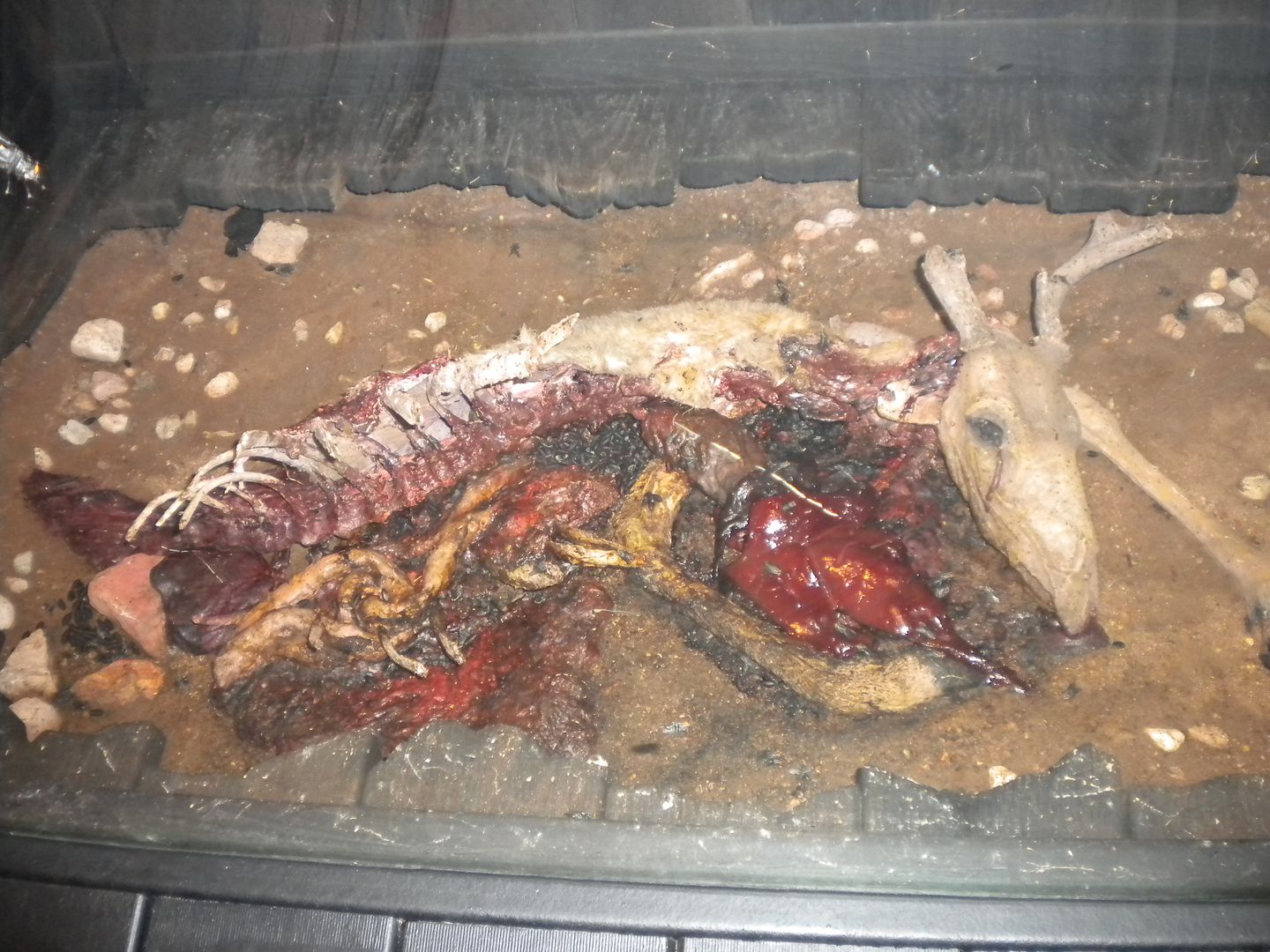
The pièce de resistance of the California Science center’s ‘Ecosystems’ exhibit, and its biggest part by far, is the “Rain Forests of the Sea” exhibit, a 188,000 gallon kelp habitat — the largest man-made of any museum in the world — that illustrates the diversity of our sea forests and the environmental factors that kelp forests depend on: a rocky substrate, sunlight, moving water, and high nutrient levels.


In the midst of the ‘Ecosystems’ exhibit is an interactive lab, where new additions to the over 250 species on exhibit at ‘Ecosystems’ are researched and cared for. In addition, it provides an opportunity for young high school students interested in pursuing science to answer guests’ questions, pursue research, and learn the scientific method in the process.

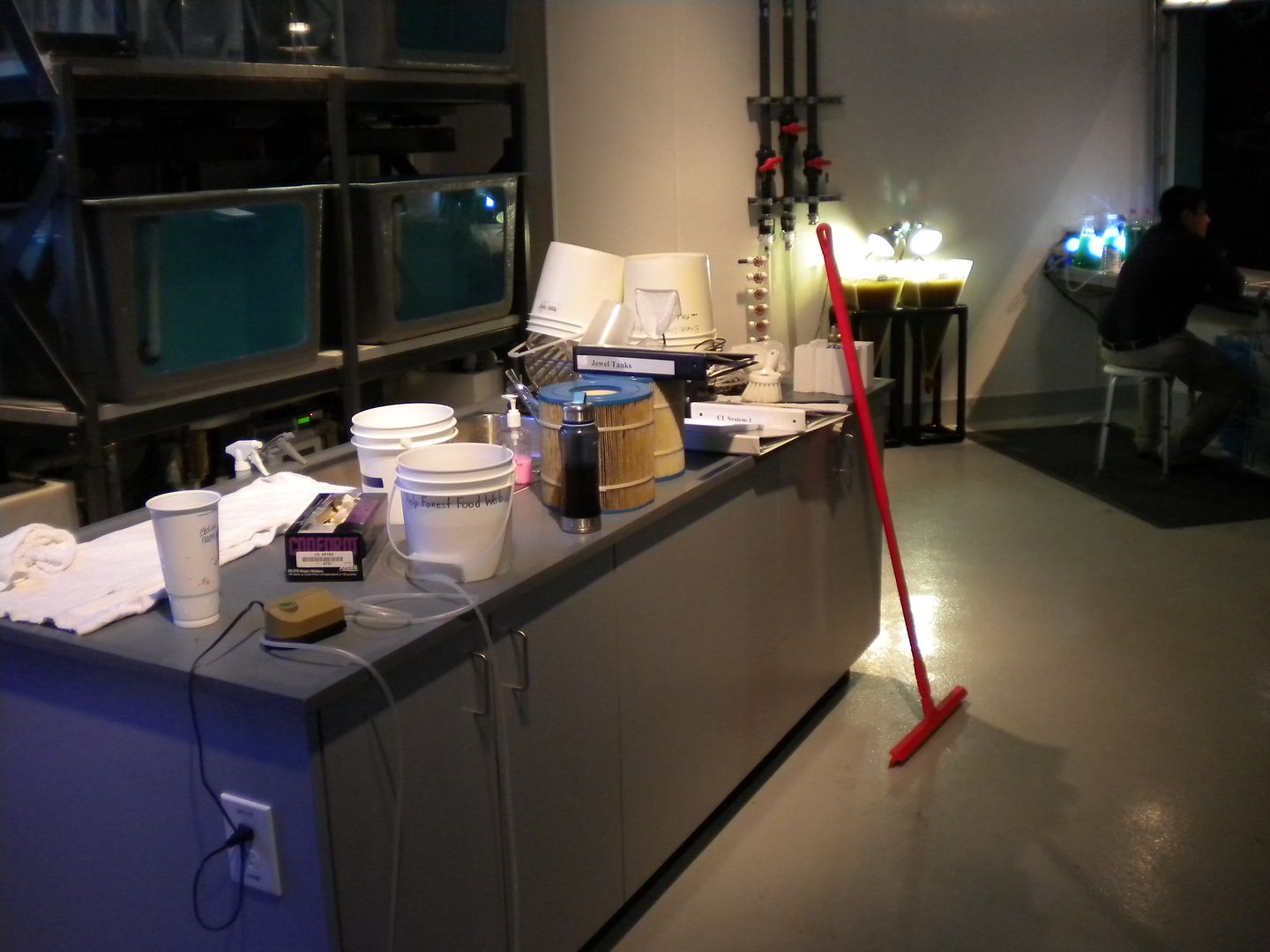
The end of the ‘Ecosystems’ exhibit takes visitors to the modern ‘L.A. Zone,’ where they can learn about weather patterns, wind currents, and geologic make-up of the Los Angeles Basin. Most importantly, visual waste exhibits expose the unique challenges in the issues of energy, water, and impact on wildlife.
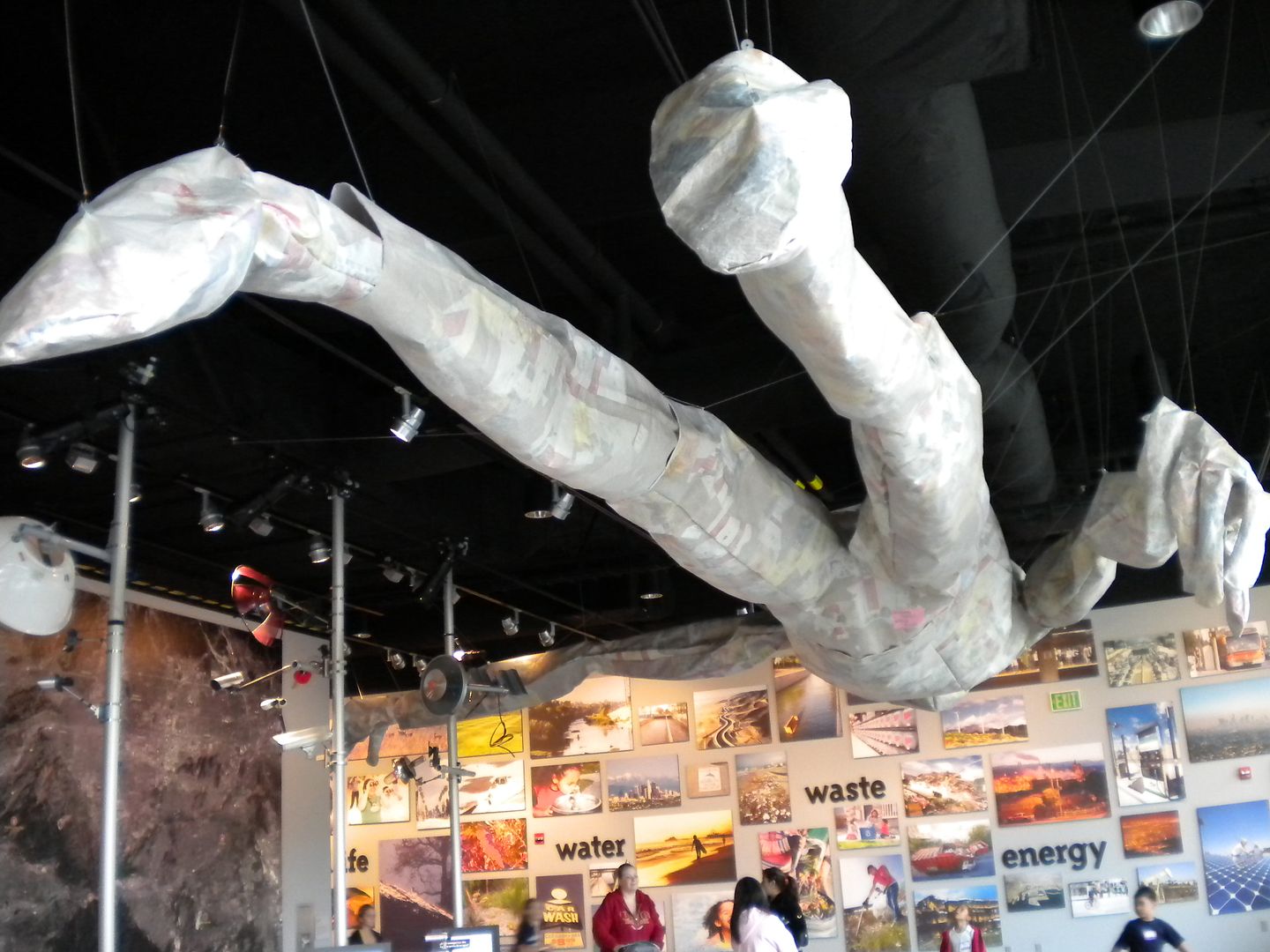

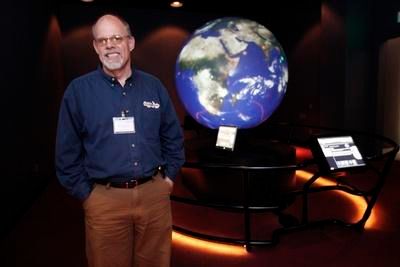
The mastermind behind such wonders as the kelp zone (his nickname is indeed Dr. Kelp!), the Global Zone, and the Los Angeles Zone, among its other structural feats, Dr. Chuck Kopczak is as intellectually accomplished as he is full of wonder about science, our Earth, the environment and the best ways to teach children about them through technology and modern exhibits. Recently, he went on a collecting expedition in Guantanamo Bay, Cuba to study species and the environment. He generously sat down with ScriptPhD.com to talk about Ecosystems, particularly:
•The how, who and why of designing the Ecosystems exhibit
•Why teaching science and inspiring future scientists requires an interactive experience
•How emotional connection resonates with environmental awareness
•Why the California Science Center is setting up labs and charter schools within their exhibit spaces to encourage young scientists
Take a listen to our podcast:
ScriptPhD.com would like to thank the California Science Center, Dr. Chuck Kopczak, and Kristina Kurasz for their help and generosity of time. We encourage anyone planning a visit to Los Angeles, and interested in science and the environment, to check out this free exhibit and learning center.
~*ScriptPhD*~
*****************
ScriptPhD.com covers science and technology in entertainment, media and advertising. Hire our consulting company for creative content development.
Subscribe to free email notifications of new posts on our home page.
]]>
Nothing has done more to reinvigorate discussions about energy and fuel dependence than the tragic oil spill currently afflicting the Gulf Coast [excellent resource for trajectory, timeline and news sources]. Though scientists and oil manufacturers continue to debate the validity of the “Peak Oil” theory, a very uncomfortable reality looms that oil production may not be able to keep up with thirsty demand. With an ever-increasing global population, a constant proliferation of technology choices and lifestyle improvements, and a rising middle class in third world countries, the factors contributing to fuel consumption may be the precipice of an eventual geopolitical crisis. In an effort to showcase their dedication to addressing the most salient energy and environmental questions affecting our generation, the Discovery Channel, backed by founder John Hendricks, is launching a revolutionary four-part documentary called Powering The Future. In it, they address a range of economics, national security, social and scientific questions related to energy and fuel all through the single focal point of searching for a modern, clean, limitless supply of energy. Our coverage of Powering the Future includes a review of the first installment and an exclusive podcast interview with the show’s host, lead scientist for the Nature Conservancy, Dr. M. Sanjayan. For full content, please click “continue reading.”
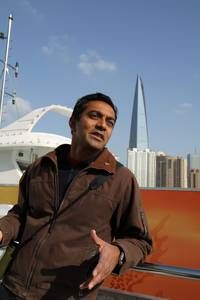
“We are the energy generation, but we as Americans do not fundamentally understand what energy is, where it comes from, how we use it, and how much we need,” remarks Dr. M. Sanjayan, host of the new Discovery Channel four-part documentary Powering The Future. Indeed, any honest retrospective of the modern energy crisis first requires a primer reviewing how our dependence on major fuel sources (coal, oil, and natural gas) came about and the unique challenges that breaking it poses. I consider myself a fairly well-informed individual, particularly on scientific matters, but in watching the first installment, The Energy Revolution, even I was amazed at the sheer interconnectedness of major electrical grids, and how much links us globally in energy delivery vessels. A German electrical engineer in the documentary compares running a major grid to being an air traffic controller.
Much of the current hope for alternative energy sources rests in grandiose ‘silver bullet’ solutions. Scientists at the National Ignition Facility are using the world’s biggest and highest powered lasers as a power source for smashing together the hydrogen atoms in a droplet of water, resulting in nuclear fusion. This mimics the way that the sun makes energy, and, if successful, would harness a limitless supply of power. Nuclear fusion research has been ongoing since the 1940s, but has never been applied successfully on a large enough scale like the undergoing experiments at the Ignition Facility. [ScriptPhD.com was recently granted an exclusive tour of the Ignition Facility, which will be covered soon in a separate post.] Another growing ‘silver bullet’ sector has been the harnessing of two natural energy sources—the sun and wind. Wind energy is the largest (and fastest-growing) alternative source of energy. Denmark gets about 20% of its power from wind sources, while the United States gets approximately 1.2%. Photovoltaic, or solar panels, more mobile and aesthetically pleasing than wind turbines, are another popular source of alternative energy. Little money has been poured into researching photovoltaic grids as a large-scale source of energy, it holds promise. The 89 petawatts of sun that shines on the Earth each year is more than 6,000 times the 15 terawatts of electrical power consumed by human. Unfortunately, both of these energy sources face one insurmountable hurdle; their mercurial natures. Our modern lifestyles require a constant influx of power, but if the sun stops shining, or the wind stops blowing, solar and wind technologies are unreliable.
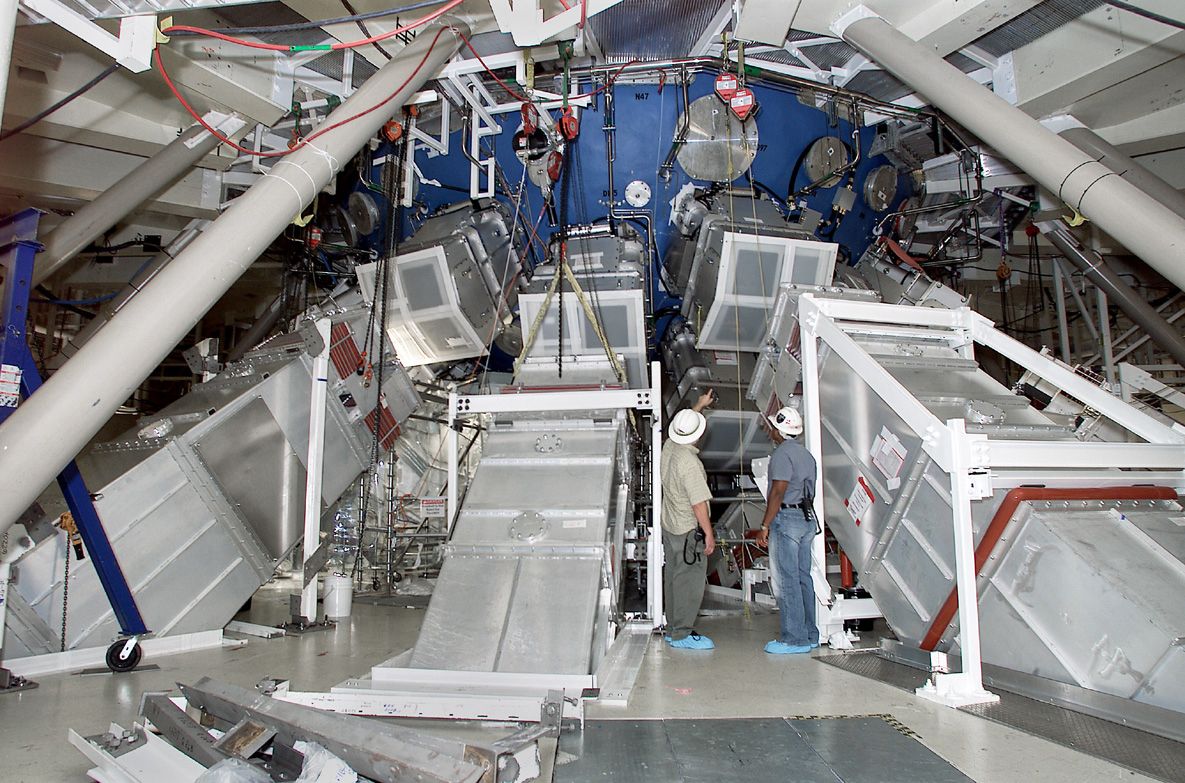
The reality is that moving energy consumption into the 21st Century will not happen with one grand discovery, but a microcosm of intermediary ones. Powering The Future provides some exciting insight into the body of research and creativity being applied to alternative energy sources. Many communities are powering themselves through clever solutions, such as Japan generating solar energy in outer space and then beaming it to Earth, or New York City harnessing wind energy from tidal waves in the East River. No role is rendered more important in this documentary than that of private organizations and academia in leading innovation and discovery. Bay Area-based Makani Power specializes in capturing and storing high-altitude wind for abundant power and energy. Caltech University solar electrochemist Dr. Nate Lewis has invented a thin coating of paint containing chemicals that catalyze the sun’s energy for power. Paint your roof, get free solar energy! In fact, just today, General Electric announced a $200 million smart grid contest for cleaner and more efficient electrical grids. The California-based X-Prize Foundation has even gotten in on the act, recently announcing a $10 million oil spill cleanup challenge.
Even those that consider themselves knowledgeable about environmental issues and research and technology of clean energy will have a lot to learn from Powering The Future. The special does an exceptional job of laying out the complex science behind concepts such as fusion and large-scale electrical grids for a lay audience to understand, while not glossing over current research in industry and academia. Moreover, rather than approaching the issue with the typical heavy-laden, moribund fatalism one often finds in these specials, Powering The Future leaves one feeling hopeful about the range of innovation happening at all levels worldwide, and the remarkable commitment of both academic labs and private companies for tireless discovery. It is this very entrepreneurial, resilient, and utterly human, attitude that will power our future more than any fossil fuel ever could.
Powering The Future premieres on the Discovery Channel on Saturday, July 17, 2010 at 8 PM ET/PT.
Finally, we encourage you to read to our exclusive one-on-one interview with Dr. M. Sanjayan, lead scientist at The Nature Conservancy, as we expand the energy discussion of the mini-series to global solutions, his thoughts on the oil spill crisis, and ways that we can impact our dependence on fuels right now.
ScriptPhD.com: Joining us today is Dr. M. Sanjayan, who is the lead scientist at The Nature Conservancy. He has a PhD from UC Santa Cruz, and is the author of “Connectivity Conservation.” His articles and appearances range from the most prestigious scientific journals to popular media such as The New York Times, and Vanity Fair and TED Talks. Thanks so much for joining ScriptPhD.com!
M Sanjayan: You’re welcome, thank you!
SPhD: It’s impossible to have a conversation about the nexus of environment and energy without addressing the oil spill afflicting the Gulf Coast. Is it safe to call this THE environmental catastrophe of our generation?
MS: Well, the generation’s not over yet. From the time of my recent memory, this has been one of the bigger wake up calls we’ve had.
SPhD: Why do you feel that way?
MS: It happened at our doorsteps, it is impacting a couple of industries that are hugely important to the United States. About a third of all the seafood you eat comes from the Gulf. About an eighth of the oysters you eat come from the Gulf. It’s a massive industry for fisheries and it also supplies about a third of all the gas that goes to heat up your house. So the Gulf is a pretty important place for America at our doorstep or seastep.
SPhD: Well, see, there’s one of the conundrums that I feel lies at the heart of this mini-series. If we take the Gulf Coast example, our President (Obama) is certainly no foe to environmental causes, and yet even he concedes that stopping offshore drilling is not practical given our thirst for oil and energy consumption. What are your thoughts on this?
MS: Well the reason that energy remains such a telling topic for our documentary is that it’s present in our entire lives. Look, I’m a pretty informed consumer and scientist, and even I was shocked at how much energy I use and all the kinds of insidious ways that energy goes into everything I do. And so if you’re looking for the culprit, in some ways, the culprit is us, it’s our thirst for big oil and it’s our thirst for this unlimited supply of energy with no repercussions, which causes us to endanger our future generations. So, it’s very difficult to point fingers when it comes to this crisis in the Gulf, even though what happened there is clearly something that BP is going to be responsible for.
But once you step a little bit beyond that, you quickly realize that how we got here and what we depend on? Still fossil fuels. I mean, [this dependence] makes hypocrites of all of us, and I think that’s the hardest part about it. That’s why it’s not comfortable to talk about, and that’s why it’s so important that we have a thoughtful dialogue about it in this country. And that’s what the show tries to do. I mean, we are addicted to just one form of energy but guess what? There’s so many other forms of energy just waiting there to be tapped. But none of them are going to come without a cost.
SPhD: In speaking about this mini-series, one of the things I adored about the first installment is that it really avoided the gloom and doom that you find typical in stories and shows pertaining to energy. Rather than dwelling on the enormity of the challenge posed to scientists, it actually made me feel hopeful about the creativity and discoveries that ARE actually out there already! Do you feel the same way?
MS: I really do, and I think that that was a conscious decision. When you talk to innovators and the people looking for the so-called “silver bullet,” you realize that Powering The Future talks to some really excited young people who are on the cusp of making gigantic breakthroughs. It’s a really sensitive section that you get carried along with. You don’t want to avoid the consequences of what we will look like if we reach 2015 with 22 kilowatts of energy needed to power our lives and all of that coming from fossil fuels. That will be a disaster and there’s no way to spin that. But we wanted to do a show that allows you to see the possibilities. People can only deal with so much – you have to give them a positive direction.
SPhD: You just mentioned the “silver bullet” – that leads perfectly into my next question. So based on your work, your travels and the research you performed in putting together this documentary, will we see the so-called “silver bullet” in our lifetimes? And if so, what are the commitments that must be made on an international level to see that happen?
MS: I wish I could tell you that there was a silver bullet and that I’ve gained a glimpse of it. I was looking for it, and I wanted to see it, and I wanted to believe in the idea of it. You’ll see that in the show. The truth is it’s more like a silver buck shot. There are lots of smart people coming up with lots of cool ideas. Some of them will go into practical use, and will be implemented on a large scale. So, there’s a lot of hope, but I don’t think it’s as simple as saying that there’s one solution that will solve it all. Now, you never know. You could see a breakthrough that happens.
The important thing is – imagine if we lived in a world where everything and everyone was completely free and available. It doesn’t mean that war and hunger and all these other things go away. There are other limiting factors that we could run up against. So, in some ways, we really want to leave it as a silver buck shot approach, because each solution also has some level of problems.
One of the more interesting [approaches] that we saw was high-oxygen kites being flown off of the San Francisco California coast. They’re really cool! You’ve got these giant kites that basically aeroform. They’re like wings of planes that fly a thousand, two thousand feet up [in the air]. And the wind blows through them, and they generate power, which then comes down a pipelines, shoots through a wire down to the Earth. What’s neat about it is when the wind drops, the power goes back up from the grid and so it stays up like an airplane. Or smart cars that you can plug into the grid, which allows you to start the car, but the car also acts as a [simultaneous] battery for the grid. Or the FULLY electric Coda vehicle that will go on sale later this year in California that will give you 100 miles. What’s amazing about the Coda for me is when you get into the car, it looks perfectly normal. It’s ordinary looking – you wouldn’t even know it’s electric.
SPhD: Well, I know one of the causes that you’re very passionate about, and have written about extensively, is poverty and coservation. On the one hand, it’s wonderful to see so many people climing out of poverty in China and India, Southeast Asia, also in Central and South America. On the other hand, with this mobility comes tremendous energy usage and environmental devastation. How do developed countries balance fostering this growth, yet holding these countries accountable for their emissions, for example through cap and trade systems?
MS: You know, people just want a better life and that’s just the truth of it no matter where you go. What is surprising, and it even shocked me, was the disparity in energy use between the Western world and countries like India or places in Africa. For my lifestyle, I use between 120-180 100-watt light bulbs’ worth of power all the time. So, about 18,000 Watts of power to power my life. The thing is, if you go to Asia, the average Asian uses about fifteen light bulbs for their life! And the average African even less – five or six. It’s an enormous difference in quality of life. And they want it to be better. There’s more people joining the middle class in India than the entire population of the U.S.
The best way we can help these countries make the transition is through economic stability, meaning better lives, happier lives, less war. Because there’s more stability and more trade. So I think the best thing that we can do is really spur innovation and development, leapfrogging technology. The partnership that we have with China, for example, to make batteries, that are a great collaboration, for the Coda car. So the Coda is made in Los Angeles, but the battery is made in China. Poor countries cannot simply abdicate their responsibilities. They’re the ones that are going to be the hardest hit by climate-induced changes. And so they have to play a role as well.
SPhD: Absolutely! Speaking of innovation, in the first installment of The Energy Planet, there are a lot of academic labs and private companies that are innovating green technology even as a lot of world governments are wringing their hands about solutions. How do you feel about some of these private companies, like Tesla Motors or the X Prize foundation here in California in enacting innovation and spurring real change?
MS: So in making Powering The Future, I thought we’d spend most of our time talking to governments – and we do do that to some degree. Energy ministers in China, and admirals in the Navy. But we found that the most passionate advocates were the private industries and the private sector. To me, that’s a very Western philosophy, but it does apply nicely. I think it’s of huge importance. Look at these big revolutions that have happened in our lifetime, like the digital revolution, and now this new revolution that’s happening with space technology or in human genetics. Governments have to play a role, and that role can be very instrumental, both in thinking about the public good and in spurring innovation through subsidies or tax breaks.
But… over and over again, I go to conferences and I come away with this notion that governments don’t lead. It’s people who lead, and the governments will follow. That’s why things like X Prize and these early innovators being out there, maybe a little ahead of the game, are hugely important. It’s exactly how the technology revolution happened with the internet, and I can see that happening with energy. It’s more complicated with energy, but it’s hugely important indeed.
SPhD: So, recycling is one of the quickest, simplest and most impactful ways that we can save energy and protect our planet. I grew up in Seattle, a very ecologically-minded city, where recycling was not only encouraged but ubiquitous, so it was ingrained in my life from an early age. But as I travel around the country, it’s shocking to me how many places there still are where the concept is foreign to the point of being anathema to the way people lead their lives. Do we go the way of the Japanese government, where you actually get fined for not separating your garbage, and they end up collectively recycling or composting anywhere from 70-80 percent of their trash, or do we provide some kind of an incentive?
MS: I didn’t realize how important that part is to solving the energy puzzle. But, one of my favorite parts of the mini-series was when we were visiting the Empire State Building, and this guy who does all the retrofitting for the building says to me “The greenest buildings are the ones that are already built.” And what he’s saying is instead of building from the ground up, you’re taking what’s already existing and recycling it. So recycling, whether on a grand scale – retrofitting a building or a rooftop garden – or on a microscale, in your own apartment, is really important.
I live in Montana right now, and it’s a great town really, but it’s still really hard to recycle there. Especially glass. And I asked them about it and the truth of the matter is that the costs to ship that glass are so expensive, that those costs prohibit recycling on a small scale in my town. It’s a complicated question. We should encourage people to recycle and to encourage their local governments to enable recycling. But sometimes you realize that it does come down to arguments of cost. As long as energy is cheap, artificially cheap (which it is), it makes it impossible to enable recycling and other programs that can make a difference on the scale which you and I would like to see happen.
SPhD: You literally traversed the globe to put together this special and you met everyone from scientists, environmentalists, oil workers and ordinary people. Can you recall for us one moment – any moment – from these journeys that really struck you and made an impact?
MS: China was pretty incredible. Because I never expected to spend that much time in the cities in China. Usually I’m going out to the countryside. There really was one moment that was very amazing to me. We went out to a little village outside of a town called Rizhao, which is China’s solar city. A city of about 3 million people that’s gone completely solar in most ways. So we went to this tiny little village right outside it, and walked into a tiny little house that a woman owned with her family. There’s five people in the family, and two rooms in the house, and a tiny little bathroom/kitchen.
She had a new shower that she really wanted to show me. It was basically a pipe that went from her room into a little private shower area. And it has hot water now because of a solar thermal unit that she’s put up on the roof. And she’ll have it paid off in five years because of the savings. She told me that in the winter, she used to endure a six-mile walk to a public bath house to have a hot shower. And now this [solar cell] completely changed their lives. Meeting her, I understood that the energy revolution is not just for the affluent and the well off, but rather it’s for all scales of life. The other thing I got in China was a lump of coal – and I actually have it sitting on my desk. And whenever I look at that lump of coal, I realize what the need is all about.
SPhD: Well, I really appreciate you joining us and giving us some insight into your travels and work.
MS: I guarantee you after watching this special, you’ll never eat a hamburger or fly a plane the same way again.
~*ScriptPhD*~
*****************
ScriptPhD.com covers science and technology in entertainment, media and advertising. Hire our consulting company for creative content development. Subscribe to free email notifications of new posts on our home page.

Happy Earth Week 2010, everyone! Here at ScriptPhD.com, we have devoted a number of articles to environment, sustainability and eco-awareness as part
of our continuing “It’s Not Easy Being Green” series. This year, in celebration of the 40th anniversary of Earth Day, we are devoting the entire week to articles, interviews and profiles of companies, individuals and content that raises awareness of sustainability efforts and new ideas for the green science revolution. Because water lies at the heart of most modern environmental crises, we kick off Earth Week with CaptainPlanet’s review of the stellar new DisneyNature documentary Oceans, a truly spectacular oeuvre that celebrates the majesty of our most important and delicate resource. We also include a number of practical, easy things you can do right now to make a difference globally by acting locally. For our Oceans review and to find out what you can do to help protect our Earth’s water supply, please click
the “continue reading” cut.
When I was three years old, my parents took me on a vacation to Atlantic City. It was my first time ever to see the ocean, and my parents were excited to see my reaction at seeing the water when we arrived at the beach that morning. Although I don’t remember the experience, I’ve been told that when I first set foot on the beach, I had a very concerned look on my face when I saw the waves pounding the shore. I ventured closer to the water to get a closer look, and upon surveying the incoming waves, I promptly turned on a dime and outran my parents back to the hotel without stopping. When my parents finally caught up with me to find out the reason for my distress, I said, “the river came out of itself,” in awestruck horror at the ocean’s power.
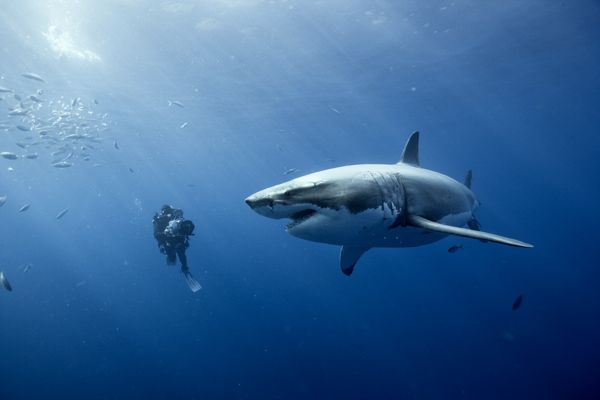
Oceans, a DisneyNature documentary premiering in theatres on Earth Day, April 22, 2010, opens on a similar theme of childhood wonder as a little boy on a beach stares out at the vastness of the ocean before him and wonders what an ocean is. As children, before we learn names for what things are called, and prior to learning about taxonomical categories in biology courses, staring at an ocean and all of its inhabitants is truly an exercise in wonder. Oceans ignites that childlike wonder while exploring the richness, beauty, danger and primordial nature of the sea. Directors Jacques Perrin and Jacques Cluzaud clearly have a knack for inciting wonder. Perrin directed the acclaimed The Winged Migration in 2001 and Cluzaud’s resume features work in IMAX films and innovative projection techniques.
Disney launched the DisneyNature label after the worldwide success of March of the Penguins in 2004. Their mission is to release one nature-related documentary per year to raise awareness about the interconnectedness of humans and nature, including what actions we can take to positively impact the environment. It is promising to see a global media corporation as hefty as Disney champion sustainability in a serious way. And it will be clear to anyone who sees Oceans, a top-notch production with stunning cinematography, narration and musical score, that Disney spared no expense to produce this film.
Pierce Brosnan, the film’s narrator, seems to have found a daft second career in narration, starting with his excellent work on the pre-recorded audio tour of the 2006 Magritte exhibit at the Los Angeles County Museum of Art. Brosnan’s voice, retaining the suaveness of his 007 days, guides us on a journey through waters of the globe. It seems at times as though the film has managed to capture every single creature that inhabits the oceans, as impossible as that would be. From whales, dolphins, sharks, sea lions, polar bears, otters, fish, crabs, shrimp, plankton, turtles, to penguins, octopi, jellyfish, and many more, it’s easy to forget just how many members of the animal and plant kingdom reside
in the oceans.
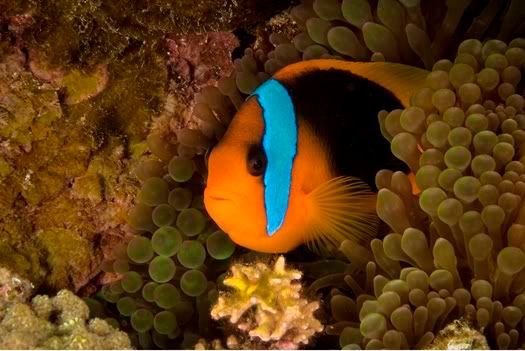
In one of the film’s most breathtaking sequences, we witness a school of sardines massacred from above and below by an army of birds, dolphins, sharks and blue whales. The sequence is an orgiastic feeding frenzy, shot from above, on the surface and underwater, accompanied by a kinetic musical score. The different animals in this sequence appear so choreographed that they invoke the ballet of dancing hippos, ostriches and alligators from the “Dance of the Hours” sequence from Disney’s animated Fantasia masterpiece. The sequence ends with a blue whale breaching the surface in the center of concentric rings of dolphins, fish and birds, a prima ballerina taking her bow.
Oceans is primarily a love letter to our world’s oceans, surveying the various topographies and lifeforms of the world beneath the surface that we often take for granted. Fortunately the film doesn’t shy away from discussing the danger that human activity poses to oceans. Although Oceans was never intended to be a hard-hitting piece of environmental journalism, it does strike a good balance between education and advocacy. The film highlights how advances in satellite imagery allow us to see where industrial pollution flows from rivers out into the open ocean, much the same way a calcified artery might appear on a heart scan. In a regular satellite photo, the river appears to be as blue as the ocean, but when the view switches to the new technology, the pollution in the river, heretofore unseen, materializes in the photo as a black, foreboding stream. The oceans have become humanity’s dumping ground for hundreds of millions of tons of trash each year. In another sequence, we see gigantic fishing nets that sweep vast swaths of water, a practice known as trawling, decimating global fish populations and killing other animals unlucky enough to get caught in the vast net. And in Antarctica, we are shown how rising global temperatures have resulted in the demise of the polar ice caps. Though the film doesn’t broach the topic directly, human water consumption is another imminent crisis facing our oceans. In a brilliant editorial, National Geographic Society chairman Gilbert Grosvenor discusses how human water usage is unsustainable and touts a National Geographic issue devoted entirely to water. (Download here.) Towards the end of Oceans, Brosnan boldly (and correctly) states that the greatest threat to the ocean is human indifference. We hope that you attend, absorb and engage in activism, even at the most basic levels to prove him (and all of us) wrong.
Coinciding with the film’s release, Disney has launched a campaign, in partnership with The Nature Conservancy, to create a protected area of coral reef in the Bahamas. Each moviegoer who attends an Oceans screening in the first week of the film’s release will help contribute to the cause. The campaign for the previous DisneyNature release, Earth, resulted in the planting of an astonishing 2.7 million new trees in the Amazon rainforest. The Nature Conservancy, founded in 1951, protects more than 119 million acres of land, 5,000 miles of rivers, and 100 marine conservation projects globally. With a staff of more than 700 scientists, they pursue their goals through science-based, non-confrontational strategies.
Oceans Trailer:
Oceans goes into wide release on Earth Day, April 22, 2010 at theatres nationwide.

•Contact your congressional representatives to voice your support for the Oceans-21 Act: a bill that adopts the key recommendations of the U.S. Commission on Ocean Policy and the Pew Oceans Commission to develop a holistic ocean health plan. This bill, unlike past ocean legislation, treats the disease, not the symptom.
•Educate yourself about the sustainability of seafood. Check out “Bottomfeeder: How to eat ethically in a world of vanishing seafood” by Taras Grescoe.
•Check out the Monterey Bay Aquarium’s guide to seafood
•Volunteer or donate to ocean related organizations. If you live by a coastal area, attend a beach clean-up.
•If going on a cruise, choose an environmentally friendly cruise line
•Support elected officials who support the ocean.
•Keep trash out of the oceans—if you don’t already, recycle, reduce, reuse and compost as much of your waste in your home and office as possible. Earth911.com is an exceptional resource for tips on recycling, finding ways to be greener, reduce waste, and purchase products made of recycled materials.
•Have more ideas for us? We’d love to hear about them in our comments section.
CaptainPlanet is an LA-based, Northwestern University-educated, eco-charged sustainability guru who loves film, psychology and saving the planet, one waterless urinal at a time…
~*CaptainPlanet*~
*****************
ScriptPhD.com covers science and technology in entertainment, media and advertising. Hire our consulting company for creative content development.
Follow us on Twitter and our Facebook fan page. Subscribe to free email notifications of new posts on our home page.
]]>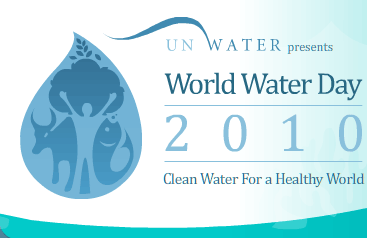
“Whiskey is for sipping, but water’s for fighting.” —Mark Twain
Today, March 22, 2010, is World Water Day, an initiative formed at the 1992 United Nations Conference on Environment and Development. As we head into Earth Day next month, no environmental issue carries more sociopolitical, economic and health ramifications than a clean and abundant supply of water. Some of the highest global morbidity and mortality rates are directly related to lack of access to clean water—both in contracting communicable diseases as well as agricultural impact that aggravates famine. At the heart of this discussion is a frenzied (and growing) thirst for bottled water; Americans alone bought more than 29 billion bottles in 2007. If you have long suspected that bottled water is not good for the environment, but only had a hazy notion about the specific consequences of the bottled water industry, Tapped, an Atlas Films documentary about to be released on DVD, will knock your socks off. The film expertly chronicles the insidious practices of bottled water companies and the dire consequences it has on our collective health, communities, environment, economy and policy in ways you never would have imagined. Our special World Water Day post under the “continue reading” cut.

Tapped features sparkly footage of bodies of water the world over, from oceans to rivers, lakes, ponds and streams. The sounds of burbling brooks and waterfalls throughout the film feel primal and urgent, as much a reminder of nature’s fragile beauty as they are a ticking clock, and the countdown is not in our favor. An opening salvo in the film’s first sequence sets the tone with a chilling statistic: by 2030, two thirds of the world will lack access to clean water. The film quickly segues into a scary question that is explored throughout the film; what happens if you take water, a requirement for life on earth, and turn it into a commodity, controlled by private corporations?
The answers are disturbing.
The first third of the film focuses on the three largest bottled water companies in America; Nestle, Coke and Pepsi. Nestle operates in the United States under multiple brands, including Poland Springs, Arrowhead, Ozarka, Ice Mountain, Deer Park and Zephyrhills. Coke owns Dasani and Pepsi owns Aquafina. Bottled water started as a small trend in America in the 1970s when Perrier introduced bottled sparkling water to urban professionals by way of small green glass bottles. But it wasn’t until 1989 when plastic bottles made from more mobile and lightweight PET plastic were introduced that the business really took off. At that point Coke and Pepsi got into the game because their soda sales were declining. The industry continued to grow at explosive rates, and by 2007 Americans inexplicably spent more than $11.7 billion on a free natural resource, something that was rightfully pegged in the film as “one of the greatest advertising and marketing feats of all time.”
Where these companies get their water is a controversial issue. Often, they buy small, cheap plots of land in small communities, install a water pump to access the community’s underground supply, and pump to their heart’s content with little-to-no overhead, taxes, regulation or accountability. The laws governing water usage in the US make this scenario possible. Surface water (oceans, lakes, rivers, etc.) is held as a public trust, and hence protected from poaching, or water mining, as the practice is often called. The loophole, however, is that underground water in most states is governed by a law established in the late 1800s called “absolute dominion,”
which basically translates to “he who has the biggest pump gets the most water.”
Small communities all over the country have been subject to this process, and often don’t know it’s happening until the corporations have already set up an operation. Communities in these situations have started organizing to stop the corporations from taking their water, but it is an uphill battle as corporations have teams of lawyers, lobbyists and other resources to advance their interests. In one small town in Maine profiled in the film, Nestle has set up a Poland Springs pump where it costs about six cents per gallon to pump water out of the ground. (A recent fight by Maine citizens, documented here and here has caused considerable headaches to Poland Springs.) The corporations then turn around and sell the water for $6.00 per gallon. This practice is happening in states around the country including California, Colorado, Arkansas and Michigan. The film points out that these corporations are setting a dangerous precedent that will allow them to control water sources in the future, which is why activists and concerned community members are desperately fighting to change the laws. Even citizens of Serbia, the birthplace of ScriptPhD.com editor Jovana Grbi?, are crying out against privatizing and selling its 300 natural springs, the most abundant in all of Europe, for water production.
When Congress tried to hold the water manufacturers accountable for depleting municipal water sources in times of drought, Pepsi testified that their water pumping had nothing to do with lowering the water levels of the local lakes and rivers. In a particularly surreal moment of the film, a Pepsi official tells a congressional panel with a straight face that beavers and their dams are to blame for lowered water levels. Dennis Kucinich (D, Ohio), the congressman leading the panel, counters back, “How many beavers would that take?” It might be funny if it weren’t so alarming. Take a look at this CNN report that resulted from revelations during the Congressional hearings:
The Environmental Devastation of Plastic
Act II of Tapped reveals the deleterious ecological and health fall-out from plastic bottles. Most of the bottles end up in a landfill or the Pacific Ocean. Often called “The World’s Largest Dump,” the Western Garbage Patch, located between Hawaii and California, is twice the size of Texas and largely composed of plastic. (An Eastern patch also exists, and video of it has been compiled here by the marine research group Algalita.) The film takes us to a bottling plant in Corpus Christi, Texas where local residents are dying from cancer due to the benzene emissions from the plant. They are often stuck living in a dangerous situation because no one wants to buy their home due to the close proximity to the plant. The film interviews several of these residents in one of the saddest moments of the documentary. One such interviewee, a man dying of cancer, says that were it not for the love of his family, he would feel like a piece of trash, his body the unwilling receptacle for toxic emissions from the faceless corporation making plastic bottles in his backyard. This man died shortly after the making of the film, and the film is dedicated to his memory.
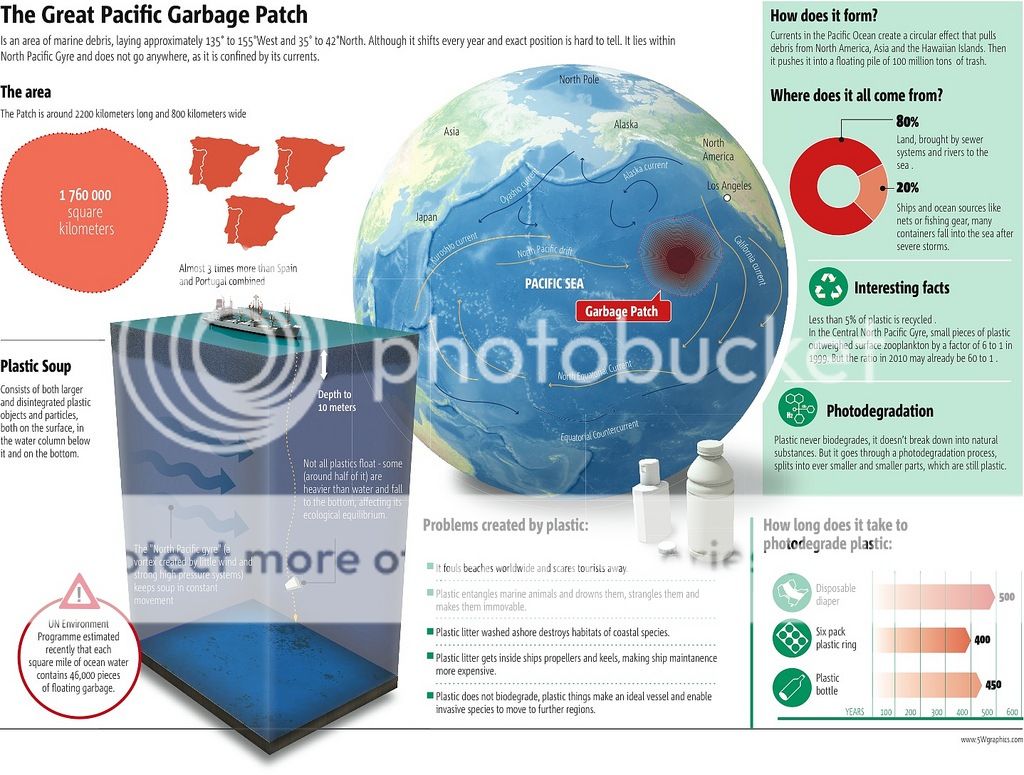
Captain Charles Moore, the founder of Algelita, appeared last week on David Letterman’s show to discuss the Garbage Patch:
About 40 minutes into the film there is a quick shot of a customer at Whole Foods placing his groceries on the conveyor belt at the cash register. The camera angle is low enough so we don’t see his face or the cashier’s face. We only see what he is buying; a sandwich, a bag of chips and a bottle of Smart Water. The image is a punch to the gut because that nameless, faceless scene has been me, too many times to count, and most likely it’s been you as well. The scene is a subtle reminder that every time we purchase a bottle of plastic water, we’ve voted “yes” for a system that is killing poor families in Corpus Christi (and elsewhere) and littering beaches in Hawaii with such large amounts of plastic that an army of dump trucks couldn’t clean it up. Even more insidious is the amount of microscopic plastic particles floating around in oceans from thrown-away plastic bottles. When one activist scoops up a handful of sand from a Hawaii beach, it looks like he’s holding a fistful of pulverized Lego’s; the plastic particles quickly replacing the sand particles. This is a result of what happens when people don’t recycle their bottles. Bottles left on the street are picked up by rainwater and washed into rivers and stream, and ultimately end up in the oceans. But recycling bottles is not exactly an entirely sustainable solution either, as the film points out. Municipalities who produce tap water, and who are in direct competition with bottled water, are often left holding the tab to recycle the leftover plastic bottles from their competitors, but with only a fraction of the budget that the corporations have.
BPA: Dangerous Chemistry
A more worrisome horror of plastic bottles is an insidious chemical called bisphenol A (BPA), used to make the hard, clear 5-gallon kind bottles most often found at a water cooler. Frederick Vom Saal, PhD at the University of Missouri, Columbia is a leading expert on BPA and its effects on human health. He calls it one of the most potent, toxic chemicals known to man because even in small amounts, it profoundly disrupts every single part of the developing male reproductive systems in lab animal studies, even at doses 25,000 smaller than any dose that has ever been studied. In larger doses, it disrupts the thyroid gland, and its been linked to a plethora of diseases from cancer to obesity, diabetes, and attention deficit and hyperactivity disorder. A recent study even found a link between BPA exposure and permanent fertility effects. These diseases have been killing people at increasingly higher rates over the last 30 years, a direct correlation to the amount of BPA floating around in consumer products over the same period of time. The FDA has not closely regulated BPA and for a long period of time, as the film reveals, relied on studies from bottle manufacturers (the people who make bottles out of BPA for a living!) that state BPA is not dangerous in small quantities. The Huffington Post recently published a series of articles revealing that BPA is found in cash register receipt paper and cardboard pizza boxes, among a host of other everyday items.

In a particularly effective scene from the film, filmmaker Stephanie Soechtig boldly asks an FDA official about their role in regulating BPA. A furious FDA press official abruptly interrupts the interview from off screen and states that if he knew BPA would be discussed, he wouldn’t have allowed the interview. The failure of the FDA to protect the public from a chemical as dangerous as BPA could be the last straw in the public’s tolerance for government incompetence and corruption, which explains why the FDA doesn’t want to discuss such a volatile subject. BPA is found in a whole host of consumer products including dental fillings, canned foods, food wrappers, food labels, and baby bottles. The good news is that due to mounting public and scientific pressure, the FDA is conducting a new study on the safety of BPA, but the $7-billion-a-year BPA industry will surely put up a fight to stop any regulation. To protect your own health, the film’s website says you should look for “BPA Free” labels whenever you buy hard plastic and avoid eating canned foods or drinking from hard plastic water bottles.
The soft plastic water bottles that most of us drink from do not contain BPA, but that doesn’t mean they are safe. As one expert in the film says, we don’t know the long term effects of drinking from PET plastic bottles. A recent British study showed that pregnant women exposed to phthalates, common across all plastics, gave birth to babies with gender defects. And in a particularly disturbing sequence from the film, the crew of Tapped buys their own samples of bottled water and sends them to toxicology labs for testing. Due to the large marketing and advertising budgets of bottled water makers, we have been led to believe for a long time that bottled water is safer than tap water. But the list of chemicals found in the bottled water, including styrene, dimethyl phthalate, and di-n-octyl phthalate, shatters that notion.
Tapped ends on a hopeful note, reminding us that change is possible, and highlighting the various battles that water activists and concerned citizens have won in recent years along with some tips for the consumer to drink filtered tap water from a reusable water container and to urge leaders to invest in our municipal water infrastructure. The Mayor of San Francisco banned bottled water at any municipal or government location. Seattle banned sales altogether at city events. Perhaps change is in effect. News outlets reported late last year that bottled water sales are starting to slump for the first time.
Look for Part II of this article containing an exclusive ScriptPhD.com Q&A between CaptainPlanet and filmmaker Stephanie Soechtig in the coming week as we continue to explore conservation issues and what can be done to enact positive change.
Take a look at this hair-raising 5:00 extended Tapped trailer:
Tapped is slated for official DVD release (with bonus features) May 1. Visit their store to purchase the DVD and Kleen Kanteen PBA-free water bottles.
CaptainPlanet is an LA-based, Northwestern University-educated eco-charged sustainability guru who loves film, psychology and saving the planet, one waterless urinal at a time…
~*CaptainPlanet*~
*****************
ScriptPhD.com covers science and technology in entertainment, media and advertising. Hire our consulting company for creative content development.
Follow us on Twitter and our Facebook fan page. Subscribe to free email notifications of new posts on our home page.
]]>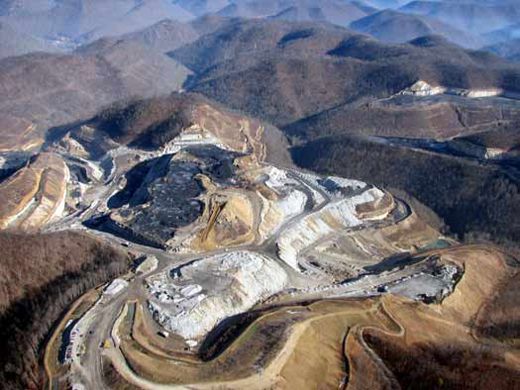
One of the most pressing issues of our time is how and where we are going to get sustainable energy for a global population with a rapidly rising standard of living and the consumption that this entails. Approximately 10% of United States coal production [coal in general accounts for 40% of global electricity production] is procured through mountaintop removal, an environmentally-devastating extraction that literally involves blasting off (or removing) the top of a mountain to extract the coal inside. The practice gained popularity in the 1960s, when it started becoming too difficult and too costly to extract coal from underground mines. In our continuing “It’s Not Easy Being Green” series, ScriptPhD.com’s eco-blogger Captain Planet talks about the documentary Mountaintop Removal, exactly what it entails, and why this process is so much more costly than the immediate energy gained from it. Please click “continue reading” for more.
“Take away wilderness and you take away the opportunity to be American.” –Roderick Nash, from ‘Wilderness and the American Mind’
If you were wondering where the sets for the land of Mordor were filmed for the Lord of the Rings trilogy, the answer would be New Zealand. But after viewing Mountaintop Removal, a well done, if homely, documentary currently in rotation on PBS and a film festival darling, the answer could just as easily have been a coal mining site in West Virginia.
So begins the story of Mountaintop Removal, with shaky aerial shots of mountains which, as you may have guessed by the name of the film, have had their tops removed. The resulting carnage of mountaintop removal is horrific in its environmental damage, toxic impact on human health, and permanent mutilation of a once-beautiful geography. As the film is quick to point out, you can cut down a forest, and eventually, it could grow back. But when you slice off the top of a mountain and extract all the coal inside, the mountain doesn’t grow back. Ever. What was once idyllic countryside in the Appalachian Mountains is quickly becoming a nightmare of epic proportions. To date, mountaintop removal has destroyed 1,000,000 acres in the Appalachian area.
The dirty secret behind goal is that it comprises 50% of the USA’s energy production. Burning coal is the cheapest way we know of to produce electricity, but it is also the most harmful in terms of the amount of carbon dioxide it produces, hastening the rise of the planet’s thermostat. Jeff Goodell, a coal specialist and author of Big Coal, says in the film that when he first started researching coal, he was surprised that we actually still use it today. He thought it had gone the way of the horse buggy and top hat. “I thought that electricity was just something that flowed down from a golden bowl in the sky. I never gave any thought to where it came from.”
So where does it come from, and how does mountaintop removal work, anyway? The organization Aurora Lights.org has an exceptional collection of information about mining, coal removal and alternative energy, and is a great resource for in-depth information. In essence, the practice of mountaintop removal is a five-part process. It begins with clearing, literally razing, burning and deforesting the trees to provide an unobstructed mining path:

The process continues with blasting, usually involving the use of dynamite to clear away earth and rock above the coal seams. This process in particular releases silica and chemical-ladden dust as airborne
particles to surrounding communities:
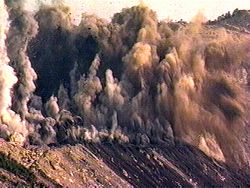
Next is the critical step of digging to clear rubble leftover from the blast and expose the coal seams directly for extraction and removal:

The rubble from the denuded mountains is dumped in the next step, called a valley fill, in which tons of rubble are relocated into the mountain’s valleys. This process has buried 1,900 miles of headwater streams (more on this below) and increased flooding during rainfall.
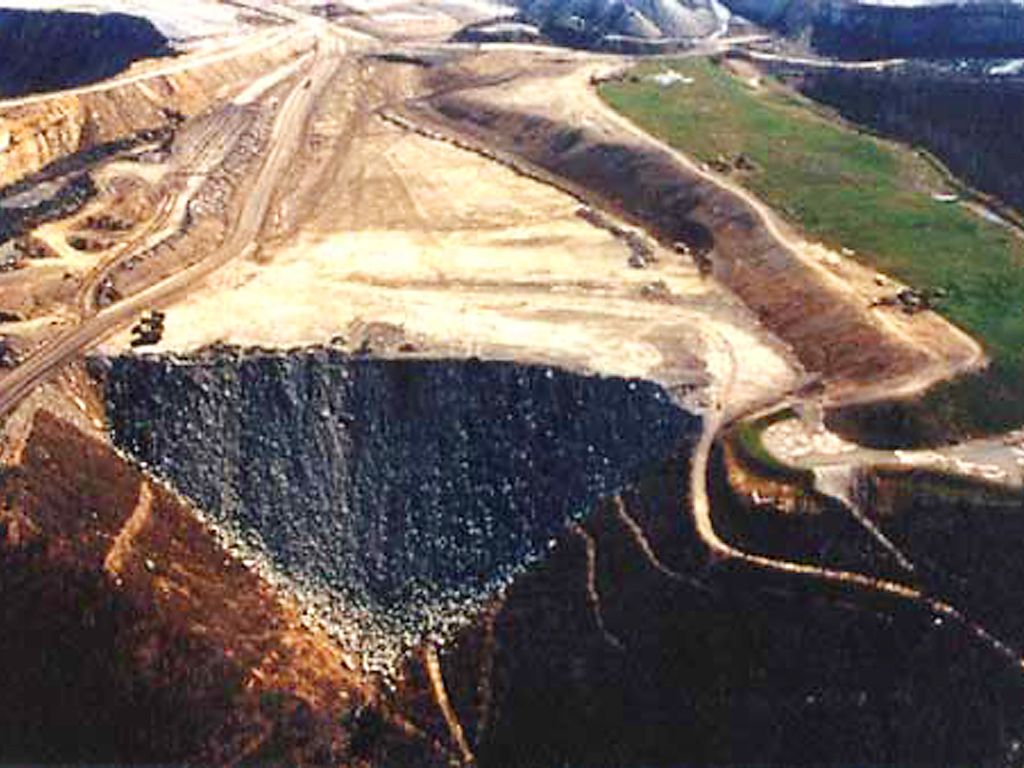
Finally, after all the coal has been mined, the barren mountainside is “replenished” reclamation, a largely superficial aesthetic process that involves planting of grass and plants, most of which will not ultimately be able to survive in the rocky ground.

If any or all of this sounds environmentally devastating, that’s because it is.
The Mountaintop Removal documentary highlights a coalition of concerned citizens who have organized to prevent further coal mining. They are comprised of college students, parents and environmentalists. The film introduces us a small elementary school in West Virginia with a coal mine in its backyard. The school sits next door to a “lake” full of coal slurry (akin to toxic sludge), which includes large volumes of lead, arsenic and cadmium. The children of the school have suffered increased rates of asthma, headaches and mouth sores, to name a few of the most common maladies. In a particularly effective scene, the parents of these school children march into the governor’s mansion unannounced and ask the Governor to relocate their children’s school to an area away from the coal mines.
The underlying issue of coal production is at the heart of our nation’s energy policy. As one interviewee so succinctly puts it in the film, we are at a crossroads where we must decide if we’re going to convert to sustainable,
green sources or continue pursuing non-renewable sources that pollute the environment and contribute to global warming. If you’ve been watching any television episodes on Hulu lately, you may have come across an advertisement for Coal River Wind. It’s a movement underway to install a fleet of wind turbines on the side of Coal River Mountain in West Virginia. It’s a race against time because Massey Energy (contact them today!), the lead coal company featured in Mountaintop Removal, has filed permits to remove the mountaintop which would destroy the wind potential. The Coal River Wind website urges visitors to write to the EPA, sign their petition and donate. It’s a microcosm of the country’s political will and long-term energy policy.
The most effective point that Mountaintop Removal ultimately makes is one of sustainability. Once the mountain ranges of Appalachia have been stripped of all coal, the coal companies will move on to other areas or dissolve. What they will leave in their wake will be broken economies, blighted landscapes and a host of health problems for anyone who is still living in the area, effectively turning the Appalachians into something like a modern-day dust bowl.
The scientific consensus on mountaintop coal mining is stunningly clear. Last month, an analysis of collected scientific studies concluded in the scholarly journal Science that mountaintop coal mining is deleterious to both the environment and human health and should be banned altogether. In all, this coal extraction process has filled 700 miles of US streams with debris, sludge and toxic pollution. Sadly, President Obama’s recent compromise with the Patriot Coal Company will steamroll [pardon the pun] a major mining project in West Virginia.
Mountaintop Removal trailer:
Websites that you can visit and organizations to get involved in to help stop mountaintop removal mining:
Coal River Mountain Watch
Ohio Valley Environmental Coalition
WV Highlands Conservancy
Mountain Justice Summer
Earthjustice
Photographer George Wuerthner has magnificently documented the ravages of mountaintop mining removal in Kentucky. The jarring mages are enough to implore you to get involved today.
CaptainPlanet is an LA-based, Northwestern University-educated eco-charged sustainability guru who loves film, psychology and saving the planet, one waterless urinal at a time…
~*CaptainPlanet*~
*******************
ScriptPhD.com covers science and technology in entertainment, media and advertising. Hire our consulting company for creative content development.
Follow us on Twitter and our Facebook fan page. Subscribe to free email notifications of new posts on our home page.
]]>
One of our most exciting continuing projects here at ScriptPhD.com is our “It’s Not Easy Being Green” series of articles, highlighting the environmental and green issues and technology solutions facing our time (see our recent Blog Action Day post). Dedicated to bringing you more in-depth and frequent green content, we are thrilled to add a new ScriptPhD contributor, CaptainPlanet, who will write exclusive movie reviews and issues for “It’s Not Easy Being Green.” He joins us with a review of The Cove, a recent documentary garnering Oscar buzz, about the secret dolphin-hunting industry in Japan and its environmental and emotional impact. If you hadn’t previously known about how majestic and advanced dolphins really are, and how deleterious the depletion of fish is across the oceanic biosphere, watch this film. ScriptPhD.com review, discussion, and ways to get involved, under the “continue reading” jump.
REVIEW: The Cove
ScriptPhD.com Grade: A
The biggest problem with The Cove, a 2009 documentary in serious contention for the Oscar, is how to describe the film in one sentence to someone without dampening their enthusiasm for wanting to see it. “It’s a movie about dolphin slaughter,” summarized director Louie Psihoyos at a recent screening in Los Angeles. The Cove is about so much more than dolphin slaughter, the filmmaker went on to say, but when you try to sum it up to someone, you’ll find yourself saying that phrase again; dolphin slaughter. Try persuading your friends and co-workers to go see a truly great film about, say, puppy murder, and you’ll soon discover the problems inherent in generating good word-of-mouth for The Cove. The good news is that the Cove is a breathtakingly good film; a suspenseful adventure in the vein of Ocean’s 11 about a small group of concerned individuals who literally risk their lives to blow the lid off of Japan’s black market of dolphin capture, killing and consumption.
The story of The Cove must be traced all the way back to 1963 with the mother of all dolphin movies, Flipper. NBC created an eponymous television series that aired from 1964 to 1967. The part of “Flipper” was played by five live female dolphins, under the supervision of one of the world’s first dolphin trainers, Richard O’Barry. One of the lead dolphins, Kathy, was sold to a major American aquarium after the series wrapped. Years later when O’Barry went to visit Kathy in her tank, he could tell that she was depressed. Kathy swam up to him, gave him a “hug,” and then turned around and committed suicide. As The Cove explains, human beings breathe automatically, but dolphins must consciously choose every breath, giving them the ability to end their own life if their conditions become unbearable. O’Barry watched Kathy’s body sink to the bottom of the tank, stunned by what he had just seen while also feeling guilty that he had not done more to lobby for her return to the wild. The next day, O’Barry was arrested at an adjacent aquarium while attempting to free another captive dolphin. Thus, an activist was born. To present day, O’Barry has dedicated his life (and sometimes risked it) to freeing captive and distressed dolphins in locations around the world, including a deceptively beautiful looking cove in the small fishing town of Taiji, Japan. He is the author of two books on dolphins, To Free a Dolphin and Behind the Dolphin Smile. For his lifetime of activism and environmental contributions, O’Barry has been a previous recipient the Environmental Achievement Award presented by the United States Committee for the United Nations Environmental Program.

Every year from September through March, tens of thousands of dolphins migrate past Taiji, Japan, where fishermen force the animals into a cove using nets and loud noises produced by banging on underwater pipes with hammers (since dolphins’ primary communication is by sonar, they are hypersensitive to noise). To escape the noise, the dolphins swim into the cove where they are trapped. From that point, the dolphins face two scenarios: being sold into captivity or being killed for lunch meat. Each year 23,000 dolphins are killed in Taiji alone. Japan is a nation that relies heavily on seafood as a food source, and it is not uncommon to see whale and dolphin meat for sale in Japanese food markets. In one scene, the filmmakers visit the seafood section of a Japanese market. They pick up pieces of meat cushioned in white Styrofoam wrapped in cellophane from a refrigerated bin. Upon closer inspection, we see that the meat in the container is an exotic dark purple color, and when the camera zooms in to capture the label, we see that the food in hand is a piece of dolphin flank. Other meats masquerading as expensive, rare seafood were analyzed by the filmmakers in a makeshift DNA lab and also found to be dolphin. A 2006 US Geological Survey report showed that oceanic mercury levels were 30% higher than in the mid-90s. Because of this, mercury levels have been steadily rising in fish meat, but some fish contain higher levels than others. Fish that are predatory (eat other fish) are large and at the top of the food chain, and so tend to contain more mercury. Dolphins fit into this category.
For years the ignominious fate of dolphins at Taiji has gone unnoticed because there is no documented footage of the capture and slaughter, mostly due to a carefully orchestrated media blackout. Most Japanese citizens in major urban centers, as The Cove is quick to point out, are not even aware that their country participates in harvesting dolphin meat for consumption. O’Barry discovered the cove at Taiji years ago and has since spent many years trying to save the dolphins from capture or death. His efforts have been thwarted time and time again by the local Taiji government, intense security surrounding the cove and blatant hostility (including bodily harm) from the Taiji fishermen. The Cove conveys beautifully how much being an environmental activist like O’Barry is dangerous work. One of O’Barry’s colleagues, Jane Tipson was mysteriously shot to death while protesting the Caribbean nation of St. Lucia for its lucrative swim-with-dolphins program. The stakes are high for dolphin activists because the dolphin trade is a billion dollar industry. A live dolphin sold from the cove in Taiji brings in a six-figure sum for the fishermen.

O’Barry realized that the only way to stop the dolphin slaughter in Taiji was to somehow capture video footage of the killings in order to create a public relations nightmare for Japan in the hopes of bringing an end to the practice, which, after an informative primer into the dolphin hunting practice, is where the movie’s plot really takes off. The makers of The Cove assembled a crack team of marine, surveillance and security experts to break into the cove and capture the grizzly footage that would ultimately be the dolphin’s best hope of survival. How and if they were able to pull it off is one of the film’s most delightful and suspense-filled elements. In the screening that ScriptPhD.com attended, audience members were actually yelling at the screen as they would at a character in a scary movie for being so dumb as to go outside to investigate a mysterious noise.
It is true that The Cove is about so much more than dolphin slaughter. It’s also about the thrill and hardship of environmental activism, the politics of the corrupt international whaling society, the impact of Western imperialism on Japan’s identity as a nation-state, the growing threat of mercury poisoning due to contaminated seafood and the general demise of Earth’s oceans at the hands of humans. But most of all, The Cove is about human’s fascination with the dolphin, a highly intelligent, arguably self-aware creature that can defy the laws of physics for its speed and grace in the water. A surfer (turned dolphin activist) describes being saved from a tiger shark by an altruistic dolphin off the coast of Australia. Reports of dolphins saving humans from sharks and drownings are very common throughout modern history. In a stunning, harrowing 2007 tale of survival, surfer Todd Endris, badly mauled by a great white shark, was saved by an insulating ring of bottlenose dolphins until the shark went away. In ancient Greece, it was actually a crime punishable by death to harm a dolphin. Why there are humans that insist on brutally killing these otherworldly creatures and why concerned citizens the world over have been unable to prevent the slaughter is an intriguing issue that The Cove explores with insight and compassion.
Like many good documentaries of recent years, The Cove was financed and made by activists. This year, the very popular Food, Inc. combined compelling storytelling with an urgent message about the need to reform an existing infrastructure. The Cove demonstrates that the judicious application of restraint goes a long way in changing hearts and minds. In one memorable scene, while interviewing a Japanese bureaucrat who defends the practice of killing dolphins, the filmmakers ask to take a sample of his hair to test it for mercury poisoning (some samples of dolphin meat have shown mercury at more than 1000 times the maximum allowable levels). It’s hard to imagine an audacious filmmaker like Michael Moore putting his opponent in checkmate in a way that doesn’t feel like a body slam, but the makers of The Cove manage it quite well throughout the film. And whereas Food, Inc. stopped short of showing graphic footage of animal slaughter, even though if such imagery would have done more to expose the ugly underbelly of factory farming, The Cove offers no such palliative censorship. By the end of the film, having brutally witnessed the process of how dolphins are trapped and killed, there is literally blood in the water.
A hit on the festival circuit this year, The Cove has already achieved some key milestones in putting an end to the dolphin business in Japan. This year in Taiji, due to pressure on the town from the film’s success, bottlenose dolphins were spared from being slaughtered. But the less popular spinner dolphins were not. The town members of Taiji are now undergoing mandatory mercury testing, and the media blackout of the dolphin killings has come to an end. Where the film will go from here is anyone’s guess. Its imminent release on DVD will help the issue resonate with wider audiences. An Academy Award nomination or win could take the film to a whole new level of exposure worldwide. As the filmmakers slyly reminded us during their Q&A, the Oscars are one of the most watched television programs in Japan.
The Cove is out on DVD and Blu-Ray December 08, 2009.
Trailer:
What can you do? First and foremost, watch the movie. Buy or the DVD, and contact the film’s press department to schedule educational, campus, museum, church, and group screenings. Nothing can match the emotional impact of witnessing the dolphin slaughter and learning the cold facts surrounding the environmentally catastrophic seafood depletion and escalating mercury poisoning. Secondly, inform yourself. Visit one of these sites to explore the issues and what you can do about them:
•Mercury poisoning facts Learn the facts about fish and mercury levels
•Article on fish depletion and a recent Science paper that posits near-total seafood depletion by 2048.
•Save Japan Dolphins, Ric O’Barry’s organization
•Oceanic Preservation Society, established by director and former world-renowned National Geographic photographer Louie Psihoyos
•The Cove Social Action Site, with links to write to leaders and other steps you can take
Finally, spread word and donate your time or money. It can make a huge difference. Take a look at this brief video by dolphin activist Rick O’Barry, along with some of the links we have provided above, and please take action today!
CaptainPlanet is an LA-based, Northwestern University-educated eco-charged sustainability guru who loves film, psychology and saving the planet, one waterless urinal at a time…
~*CaptainPlanet*~
*****************
ScriptPhD.com covers science and technology in entertainment, media and pop culture. Follow us on Twitter and our Facebook fan page. Subscribe to free email notifications of new posts on our home page.

